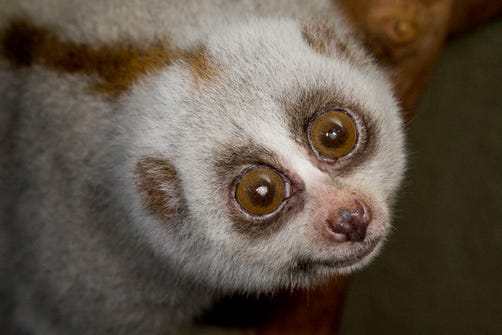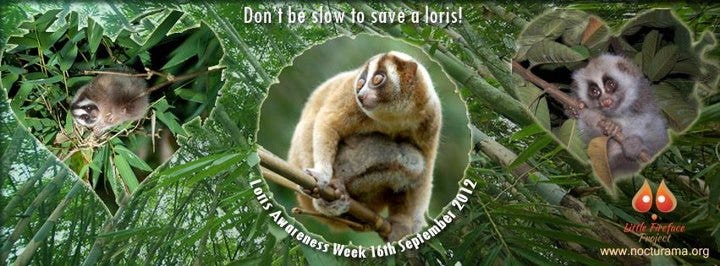By Jordan Schaul | National Geographic | September 10, 2012
Direct you know where you might find an Asian lorisine prosimian at the zoo? “Not a chance,” I would say—at least that’s what I used to say—until I was introduced to one as a professional zookeeper.
As a kid, enamored with zoos and zoo animals, I was impressed with charismatic megafauna and utterly unimpressed with anything less. It wasn’t until I actually joined the ranks of my professional zoo colleagues that I discovered certain critters even existed on this planet—like the fascinating and remarkable slow loris.
Before the advent of zoogeographically-themed, immersion exhibits, members of these 5 species of extant lorisine prosimians, named after the Dutch word for “clown,” were typically displayed only in nocturnal houses and small mammal exhibits or viewable off exhibit. I only ventured into such buildings as a shortcut to get somewhere else. I couldn’t tell you what was inside them and I certainly knew nothing about the natural history of lorisids.
Today people are drawn to these more “humble” denizens of the night, in part because they are displayed in more engaging naturalistic exhibits than ever before. They are also displayed as a part of an assemblage of South Asian fauna, which conveys the role of these little primates in their forested ecosystems.
Through the placement of animals in an appropriate educational context, these living institutions are teaching people to protect habitat as far away as Indonesian rainforests. And indeed, they are helping to conserve species on the brink of extinction beyond lorises and other flagship species that are found in prestigious zoological park collections. But zoos and prosimian biologists need more help to get the word out about these vanishing species and fast.
Lorises are insectivorous, lower primates that are disappearing quickly as a result of several factors, which impact a multitude of other faunal groups in the region. Habitat loss, collection for the pet trade, and use in Eastern Medicine are three primary issues influencing the demise of these prosimians.
To draw attention to the plight of slender and slow lorises, we announce the celebration of Loris Awareness Week, which begins next week.
Here is a link to the Los Angeles Zoo’s natural history profile for slow lorises. And to learn more about what you can do to conserve these rare creatures, visit the website of prosimian biologist Dr. Anna Nekaris and her team of researchers.
ABOUT NATIONAL GEOGRAPHIC SOCIETY
The National Geographic Society is a global nonprofit organization that uses the power of science, exploration, education and storytelling to illuminate and protect the wonder of our world. Since 1888, National Geographic has pushed the boundaries of exploration, investing in bold people and transformative ideas, providing more than 14,000 grants for work across all seven continents, reaching 3 million students each year through education offerings, and engaging audiences around the globe through signature experiences, stories and content. To learn more, visit www.nationalgeographic.org or follow us on Instagram, Twitter and Facebook.
MEET THE AUTHOR
Jordan Carlton SchaulWith training in wildlife ecology, conservation medicine, and comparative psychology, Dr. Schaul's contributions to Nat Geo Voices have covered a range of environmental and social topics. He draws particular attention to the plight of imperiled species highlighting issues at the juncture or nexus of sorta situ wildlife conservation and applied animal welfare. Sorta situ conservation practices are comprised of scientific management and stewardship of animal populations ex situ (in captivity / 'in human care') and in situ (free-ranging / 'in nature'). He also has a background in behavior management and training of companion animals and captive wildlife, as well as conservation marketing and digital publicity. Jordan has shared interviews with colleagues and public figures, as well as editorial news content. In addition, he has posted narratives describing his own work, which include the following examples: • Restoration of wood bison to the Interior of Alaska while (As Animal Curator at Alaska Wildlife Conservation Center and courtesy professor at the University of Alaska) • Rehabilitation of orphaned sloth bears exploited for tourists in South Asia (As executive consultant 'in-residence' at the Agra Bear Rescue Center managed by Wildlife SOS) • Censusing small wild cat (e.g. ocelot and margay) populations in the montane cloud forests of Costa Rica for popular publications with 'The Cat Whisperer' Mieshelle Nagelschneider • Evaluating the impact of ecotourism on marine mammal population stability and welfare off the coast of Mexico's Sea of Cortez (With Boston University's marine science program) Jordan was a director on boards of non-profit wildlife conservation organizations serving nations in Africa, North and South America and Southeast Asia. He is also a consultant to a human-wildlife conflict mitigation organization in the Pacific Northwest. Following animal curatorships in Alaska and California, he served as a charter board member of a zoo advocacy and outreach organization and later as its executive director. Jordan was a member of the Communication and Education Commission of the International Union for the Conservation of Nature (CEC-IUCN) and the Bear Specialist Group of the IUCN Species Survival Commission (BSG-SSC-IUCN). He has served on the advisory council of the National Wildlife Humane Society and in service to the Bear Taxon Advisory Group of the Association of Zoos and Aquariums (AZA Bear TAG). In addition, he was an ex officio member of the council of the International Association for Bear Research and Management.




